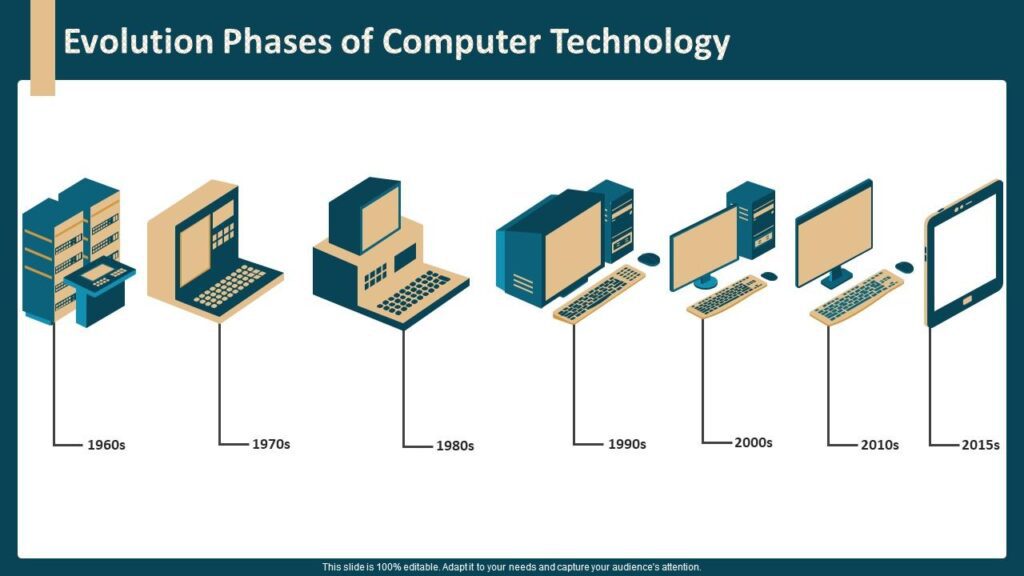The First Computer: The Birth of a Revolution
The history of modern computing begins with the creation of the first digital electronic computer. This innovative machine was developed during World War II in response to the need to perform complex calculations quickly and accurately. The first computer of this type, known as ENIAC (Electronic Numerical Integrator and Computer), was built by John Presper Eckert and John Mauchly at the University of Pennsylvania and completed in 1945.
ENIAC took up an entire room, weighed about 30 tons, and used more than 17,000 vacuum tubes. Despite its size and complexity, ENIAC was able to perform calculations in seconds that previously would have taken days. His ability to perform mathematical operations at unprecedented speed ushered in the era of digital computing.
The First Generation Computer Era

First-generation computers, such as ENIAC, used vacuum tubes for their circuits and magnetic drums for memory. These devices were extremely large, expensive, and consumed enormous amounts of energy. However, they laid the foundation for the future development of computer technology.
An important milestone in this era was the development of the UNIVAC I (Universal Automatic Computer I), the first mass-produced commercial computer in 1951. The UNIVAC I was used by the United States government and private companies, demonstrating the potential of computers in commercial and scientific applications.
The Transition to Transistors: Second Generation
The invention of the transistor in 1947 by John Bardeen, Walter Brattain, and William Shockley at Bell Labs revolutionized computing. Transistors replaced vacuum tubes, allowing the creation of smaller, faster, and more energy-efficient computers. Second-generation computers, which began to appear in the 1950s, used transistors and also introduced the use of high-level programming languages, such as FORTRAN and COBOL.
This new technology allowed the development of more accessible and practical computers for a variety of applications. Computers began to be adopted by universities, businesses, and governments around the world, ushering in the global expansion of computing.
Large Scale Integration: Third Generation
The third generation of computers, which emerged in the 1960s, was characterized by the use of integrated circuits (chips). These chips, which contained multiple transistors in a single component, allowed for greater miniaturization and efficiency. Computers of this generation were more powerful and reliable, as well as being more affordable and accessible to businesses and educational institutions.
IBM, a leading technology company, launched the IBM System/360 series in 1964, a family of compatible computers that could be used for a wide range of applications. This series set standards that would influence computer design for decades to come.
The Microcomputer Era: Fourth Generation
The fourth generation of computers began in the 1970s with the introduction of microprocessors. A microprocessor is a chip that contains the central processing unit (CPU) of a computer. The first microprocessor, the Intel 4004, was released in 1971 and marked the beginning of the microcomputer era.
Microcomputers, or personal computers (PCs), revolutionized computing by making it accessible to individuals and small businesses. Apple and Microsoft emerged as leaders in this emerging market. In 1981, IBM launched its own PC, which helped standardize the architecture of personal computers.
The Internet Revolution and the Fifth Generation

The development of the Internet in the 1990s transformed computing once again. Computers were no longer isolated machines; They were now connected in a global network, allowing instant communication and access to a vast amount of information. The World Wide Web, created by Tim Berners-Lee in 1989, became a crucial platform for online interaction and commerce.
Fifth-generation computers are characterized by the use of artificial intelligence (AI) and cloud computing. These technologies make it possible to process large amounts of data and perform complex tasks that were previously unimaginable. Companies like Google, Amazon, and IBM are at the forefront of these innovations, developing systems that can learn and adapt as they are used.
The Future of Computing
Computing continues to evolve at a rapid pace. Emerging technologies such as quantum computing and advanced artificial intelligence promise to take computing capabilities to levels never seen before. Quantum computing, in particular, has the potential to solve problems that are intractable for classical computers.
Furthermore, the integration of computing into everyday devices through the Internet of Things (IoT) is creating an increasingly interconnected world. From self-driving cars to smart homes, computing technology is transforming every aspect of daily life.